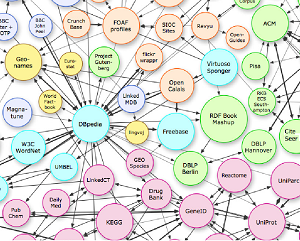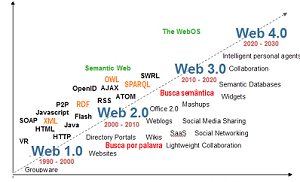
Posts Tagged ‘Web 3.0’
Web 3.0: coining words and give them meaning
Web is not just that I’m talking about, but also and especially of people, make sense, especially human, the things around us requires thought and act more and more just on impulse .
especially human, the things around us requires thought and act more and more just on impulse .
On this blog I spoke earlier of the word selfie, but I have already spoken of Instagram and ordinary people and everyday landscapes that go through our day to day “photographic”, so too is the case of Web 3.0, or fashion trend?
John Markoff was who coined the word Web 3.0 in the New York Times , Web 2.0 has already happened , it created hundreds or thousands of applications ( Apps of considering the cell ) and included the common user as producer of information , now photos , posts , comments and ” hashtags ” are there calling our attention , but these people should ALWAYS be seen and heard , they were not.
The problem of our day to day , and also that the Web is a reflection and not an idealization of the day – to-day as some think , is that much that ” lacks ” direction , and found thousands of photos to look at , words and videos means that we need them or them offering new significance .
John Markoff suggested simple questions such as: “I’m looking for a warm place to vacation and I have a budget of $3,000. Oh, and I have an 11 year-old child”, but actually thought of business , as own title and article suggest, by example Spivak company, Radar Networks, working on the holding of the content of social computing sites , which allow users to collaborate in gathering and adding their thoughts to a large amount of contents, travel movies.
But Web 3.0 now seems to be finding its way , projects like DBpedia and VIAF ( Virtual International authorit File) are indicating a more social than technical , although it may contribute to this, there is still a way in this ” construction ” .
More about Web 3.0
When Tim Berners – Lee , James Hendler and Ora Lassila inaugural paper published the Semantic Web : new form of Web content that is meaningful to computers will unleash a revolution of new possibilities , much of the subsequent development of the Semantic Web was designed : to express meanings , knowledge representation , ontologies , intelligent agents , and finally an “evolution of knowledge.”
Semantic Web : new form of Web content that is meaningful to computers will unleash a revolution of new possibilities , much of the subsequent development of the Semantic Web was designed : to express meanings , knowledge representation , ontologies , intelligent agents , and finally an “evolution of knowledge.”
The article pointed out the path of ontologies as a way “natural ” for the development and add meaning to information in the Semantic Web , methodologies coming from Artificial Intelligence , which in the eyes of James Hendler ( Web 3.0 ) that passed through a “winter ” creative .
But three integrated tools just indicating a new path : ontologies helped build schemes simple organization of knowledge called ( SKOS – Simple Knowledge Organization of System) , a database for consultation with a language called SPARQL and what was already basic Semantic Web , which was the RDF (Resource description Framework ) in its simple descriptive language : XML.
The Web for a set of tools already developed as Web 2.0 , making the consumer also a producer of contents and ” semantic links ” , it now web in which data can be linked and regardless of the tool, one can think and there are already projects with “open linked data”, a self structuring Web.
The first major project was the DBpedia , a database proposed by the Free University of Berlin and the University of Leipzig in collaboration with the project OpenLink Software in 2007 , which was structured around the Wikipedia , using 3.4 billion to form concepts 2:46 of RDF triples ( resource , property and value) or more simply subject-predicate – object , indicating a semantic relation .
Around these data were added one large number of data including : data Average (in Blue), Geographical (in yellow), publications (in green), the government (light blue), crossing domains (dark blue) and life sciences (red) .
Realities and fantasies of Web 3.0
In November 2006 , John Markoff wrote in the New York Times , using the term Web 3.0 , saying that she would find  new ways of mining human intelligence : ” From the billions of documents that form the World Wide Web (WWW) and the links that bind them, computer scientists and a growing group of new businesses … ” (see New York Times).
new ways of mining human intelligence : ” From the billions of documents that form the World Wide Web (WWW) and the links that bind them, computer scientists and a growing group of new businesses … ” (see New York Times).
Definitions vary enough from those who think the customization features to the Semantic Web and barrel , from costumes like Conrad Wolfram thinks that Web 3.0 will be the place where ” the computer will generate new information ” , even pessimistic as Andrew Keen ( the Cult of the Amateur) you see in Web 3.0 a return to experts and authorities , calling it ” unrealisable abstraction ” , the idea of connecting and organizing information on the Web
Consider a text actually founding text of James Handler , published in IEEE Computer January 2009 : ” Web 3.0 emerging ” on to explain that after countless laps around the Semantic Web technology has finally found that can help her accomplish – themselves.
The article explains the technology integrated into the emerging Semantic Web are already starting to produce results, from basic applications using RDF description ( in the description of resources, link data from multiple Web sites using a standard language SQL , the SPARQL query that RDF to connections that are ready in XML or OWL ontologies .
Far from being utopian , so the scenario of the Semantic Web is now real and results .

